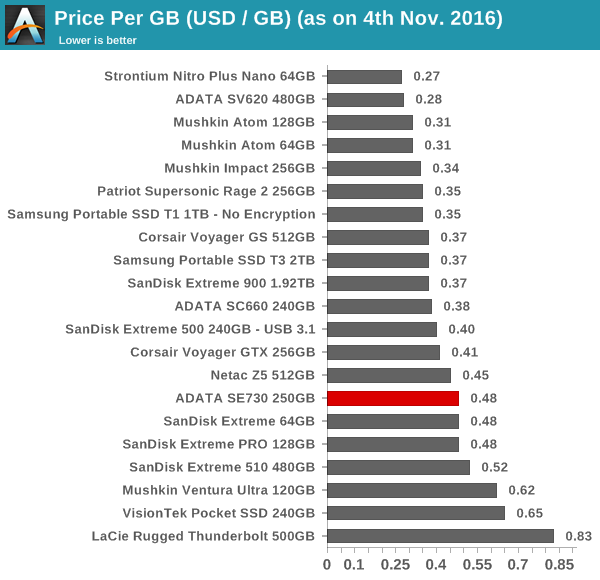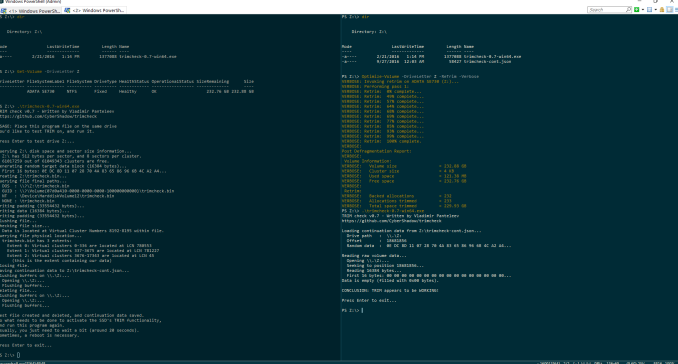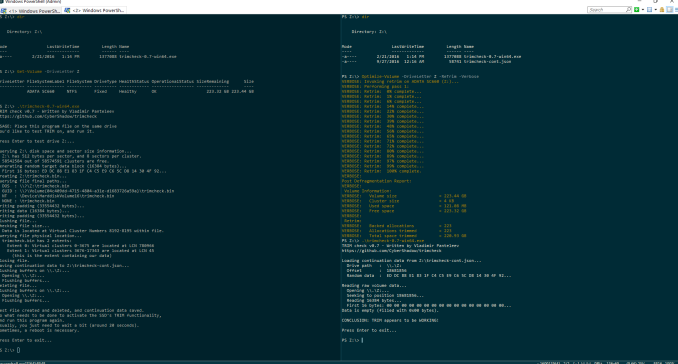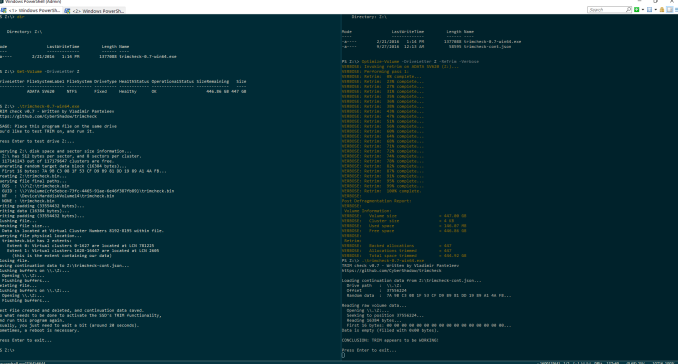ADATA SE730, SV620 and SC660 External SSDs Review
by Ganesh T S on November 4, 2016 2:15 PM ESTMiscellaneous Aspects and Concluding Remarks
External flash-based devices that support UASP fully can translate the SCSI UNMAP command to TRIM commands for the controller connected to the internal SSD. We already saw that the SC660 and SV620 do not support the NCQ feature of UASP. But, it is still worthwhile to check if the TRIM command is passed through the bridge chip. We already know from our evaluation of the Satechi USB 3.1 Gen 2 Type-C enclosure that the VIA Labs VL716 is capable of passing TRIM commands downstream. We expected no trouble with the SE730 on this front, but, it was worth testing out.
Checking for TRIM support has been a bit tricky so far. CyberShadow's trimcheck is a quick tool to get the status of TRIM support. However, it presents a couple of challenges: it sometimes returns INDETERMINATE after processing, and, in case TRIM comes back as NOT WORKING or not kicked in yet, it is not clear whether the blame lies with the OS / file system or the storage controller / bridge chip or the SSD itself. In order to get a clear idea, our TRIM check routine adopts the following strategy:
- Format the SSD in NTFS
- Load the trimcheck program into it and execute
- Use the PowerShell command Optimize-Volume -DriveLetter Z -ReTrim -Verbose (assuming that the drive connected to the storage bridge is mounted with the drive letter Z)
- Re-execute trimcheck to determine status report
Conclusions can be made based on the results from the last two steps.
All the three external SSDs have no problems in supporting TRIM commands from the OS.
ADATA has been in the SSD market for quite some time, and it is good to see them come out with options for the external high-performance USB flash storage devices market. The SE730 is a very compelling product with the right mixture of features for its price. It is both dust and water-proof, uses MLC flash, has consistent performance and comes with TRIM support. The only other sturdy external SSD that we have evaluated before - the SanDisk Extreme 510 - came with an IP55 rating (compared to the IP68 of the ADATA SE730), and had trouble with thermal throttling under sustained traffic. The ADATA SE730 has no such issues. We have no reservations in recommending the SE730 to consumers looking for a compact, sturdy and durable external SSD.
Things are a bit different on the SV620 / SC660 front. The SLC caching scheme may work great for the internal drive usage patterns of the average consumer, but, it is not a good for write-intensive direct-attached storage workloads. The two external SSDs are meant to be affordable options, and as long as the end user understands the constraints involved (suitability for read-intensive usage patterns), they could turn out to be good value for the money. The performance consistency issue for write workloads prevents us from giving an unqualified recommendation for the SV620 and SC660.
The final aspect being considered today is the pricing. We find that the SE730 carries a bit of a premium (almost US $0.50 per GB), but the SV620 480GB version is almost as cheap as a thumb drive in terms of cost per GB. The SE730 250GB has a street price of $120, while the SV620 480GB version comes in at $135. The SC660 240GB version reviewed in this article has a street price of $90.

All said, the three external SSDs from ADATA form an interesting trio and target different price points and usage scenarios. We have no qualms in recommending the SE730, while the SC660 and SV620 are to be considered only after a careful understanding of the trade-offs involved.













9 Comments
View All Comments
stephenbrooks - Friday, November 4, 2016 - link
The construction of the SE730 is quite interesting because if the user didn't want it external any more they could plug the M.2 2242 module into their motherboard? I wonder if you could put a different M.2 drive in the casing?zodiacfml - Sunday, November 6, 2016 - link
Thinking the same thing....but I don't see myself purchasing such as these drives are more expensive and large compared to thumb drives to be used as portable storage. Working pros will benefit from the performance of these external drives.Wardrop - Monday, November 7, 2016 - link
Performance is definitely the main reason you'd be a drive like this. Been considering buying an external SSD for my Mac to bring it a little closer to performance to the internal SSD.Michael Bay - Saturday, November 5, 2016 - link
What about data retention? Such drives can spend a lot of time unplugged, I think, so it becomes actuall important.BrokenCrayons - Tuesday, November 8, 2016 - link
That's a good question. It's probably more of a concern for TLC models, but I can't imagine there's a way for Ganesh to test long term data retention and still write a review in a timely manner.pberger - Monday, November 7, 2016 - link
I just bought a new 4TB 2.5" external HDD (Seagate backup plus) for just under $100.Those SSD drives are about 10x more expensive, I pass!
Ithaqua - Monday, November 7, 2016 - link
Give it time.I'm replacing 2@2TB & 1@4TB with 2@8TB external HDD drives (I'd go 10 or 12TB if I could find them cheap).
But when I got the 1st 2TB the cost would be 50-100X for SDD. Now it's 10-20X for SDD. When it gets down to 4x (for me at least) that extra speed with USB 3.1 or 4.0 (or whatever it will be) will be a deciding factor.
BrokenCrayons - Tuesday, November 8, 2016 - link
Yup, for mass storage, it'll be a while before SSDs catch up in cost effectiveness, but I do think that since hard drive sales are slowing down, less R&D budget will be dedicated to capacity increases and mass production benefits will be more difficult to realize due to declining demand. It certainly looks like solid state storage is poised to catch up sooner or later.Like Mikey Bay mentioned in an above post, there's still some data retention problems with current NAND technologies and there's the write endurance problem too in some halo use case situations. For the next few years, I can't see mechanical hard drives going away since they have some small advantages in that respect as long as speed isn't a concern.
I've got to mention that I like solid state external storage though. I had a 120GB BP4 mSATA drive that came out of a laptop that failed. I popped the drive into a tiny USB 3.0 enclosure and it's nice to have something a little quicker than a standard thumb drive that's also pretty much drop-proof to shuffle files around. It's currently serving as a backup disk for documents, photos, and that sort of junk and it does the job nicely.
Ethos Evoss - Sunday, November 13, 2016 - link
Another pointless external ssd enclosure which will NEVER support TRIM as it is via USB interface..Such marketing..